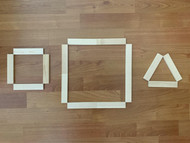Measuring Perimeter with KEVA
Posted by Kate Meyerhoeffer on Apr 5th 2024
Determine perimeters with a non-standard unit of measurement.
MATERIALS:
- 25 planks per child
- KEVA "Yardsticks" (Several Yardsticks per classroom can be shared among students)
PROCEDURE:
- Discuss the concept of perimeter being the distance around an object.
- “Today we will be measuring with a unit of measurement that is uniform but not the standard, such as an inch or centimeter would be. We will be using a KEVA length as our unit.”
- Show the class the KEVA yardstick. Show how you could tell how tall a table is with the KEVA yardstick.
- Have the students construct a triangle using three KEVA planks. What is the perimeter measured with the KEVA yardstick? [3]
- Have the students construct a square with a perimeter of 4; with a perimeter of 8.
- Have the students construct a rectangle with a perimeter of 12; a perimeter of 24. Ask if all the rectangles look the same. Is there more than one way to make a rectangle with a perimeter of 20? [Yes.]
- Write the formula for the perimeter of a rectangle on the board:
P = S + S + S + S or P = (2 x S1) + (2 x S2) or P = 2 x (S1 + S2) - Have the students construct rectangles for their neighbors to determine the perimeters.
- Have students in small groups construct as many different rectangles as they can with perimeters = 16; perimeters = 20; perimeters = 24. (Remind them that a square is a type of rectangle.)
©2019 KEVA Planks. All Rights Reserved.

